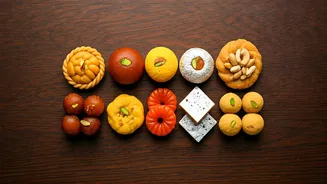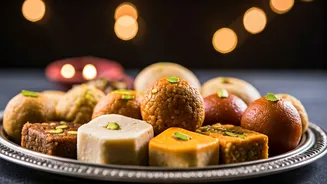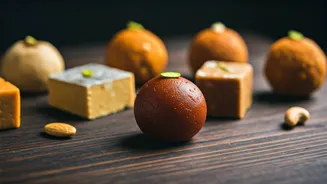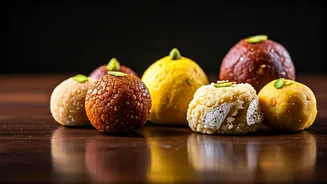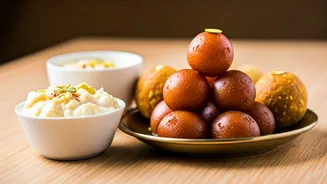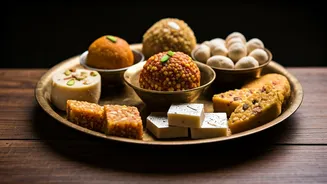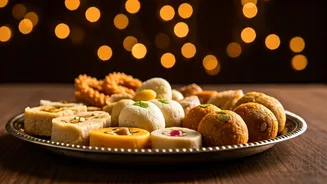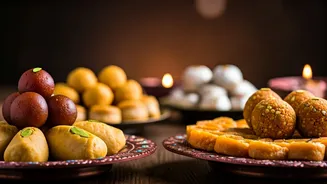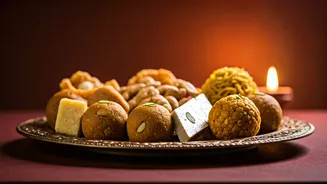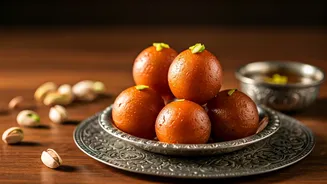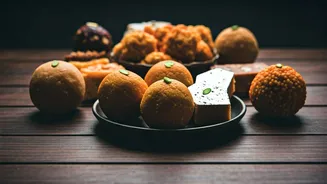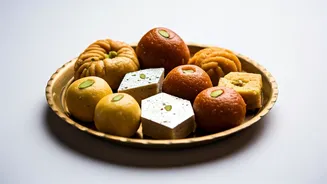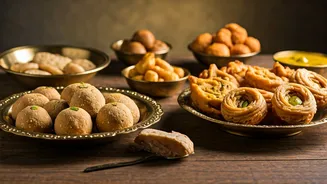Introduction to Sweets
Embarking on a culinary journey into the realm of Indian desserts is like opening a treasure chest filled with sweetness. These treats are more than just
a conclusion to a meal; they're an integral part of Indian culture, often associated with celebrations and joyous occasions. The best part? Many traditional Indian desserts can be easily adapted to suit children's palates and nutritional needs. This article presents ten such recipes, crafted with simplicity in mind. They balance traditional flavours with ease of preparation, ensuring that parents can create delightful treats without spending hours in the kitchen. These recipes are designed to be child-friendly, offering options that range from familiar favourites to exciting new discoveries. Get ready to whip up a storm of deliciousness that will have the little ones asking for more. From the first bite to the last, these treats will be a hit!
Gulab Jamun's Charm
Gulab Jamun, those irresistible deep-fried milk balls soaked in a fragrant sugar syrup, are a classic. The preparation involves making a dough from milk powder, all-purpose flour, and baking powder. These are then shaped into small balls and deep-fried until golden brown. The fried balls are then immersed in a sugar syrup infused with cardamom and rose water. The key to perfect Gulab Jamun lies in maintaining a consistent temperature during frying and ensuring the syrup is the right consistency. Kids love Gulab Jamun for its melt-in-your-mouth texture and sweet, floral taste. Parents can make it healthier by using a less sugary syrup. Gulab Jamun is a great treat for celebrations, and it can be paired with vanilla ice cream for extra fun. It is relatively easy to make, and kids would be charmed by the round, soft, sugary goodness.
Kesar Peda Bliss
Kesar Peda, often referred to as saffron fudge, presents a less elaborate yet equally appealing dessert. The base for Kesar Peda is usually made from milk solids (khoya or mawa), sugar, saffron strands, and cardamom powder. Khoya is gently simmered with sugar until the mixture thickens. Saffron strands are added for colour and a distinct flavour, and cardamom contributes an aromatic touch. The mixture is then shaped into small, flat discs or balls, with a pistachio or almond for garnish. Kesar Peda is celebrated for its rich, creamy texture and subtle sweetness. Kids would love its vibrant colour and the pleasing aroma. Making Kesar Peda is simple, and it provides a great way to introduce children to the nuanced flavours of saffron and cardamom, contributing to their culinary adventure.
Ladoo Delightful Varieties
Ladoos encompass a family of sweet balls, each with its unique ingredients and flavour profile. Besan ladoo, made from gram flour (besan) roasted in ghee and mixed with sugar and cardamom, is a popular choice. Another favourite is the Motichoor ladoo, which involves frying tiny droplets of batter and soaking them in sugar syrup before shaping. Then there is Rava ladoo made using semolina, dry fruits and ghee. Making ladoos requires patience, especially when shaping them, but the result is a rewarding treat. The advantage of ladoos is the versatility in adapting them to different tastes and dietary needs. For example, nuts and seeds can be added to boost the nutritional value, while jaggery can replace sugar for a healthier option. The variations ensure there is a perfect ladoo for everyone, from traditional recipes to healthier versions.
Gajar Ka Halwa Magic
Gajar Ka Halwa, a carrot pudding, is more than just a dessert; it’s a colourful blend of flavours and textures. This rich dish combines grated carrots, milk, sugar, and ghee. The carrots are slow-cooked in milk until tender, then sugar and ghee are added. The final touch involves garnishing with chopped nuts. Making Gajar ka Halwa is time-consuming, but the delightful outcome is well worth the effort. It's a great way to sneak in some healthy veggies. Gajar ka Halwa provides a dessert option that balances indulgence and nutrition. It offers a slightly different texture to the traditional sweets and is loved by children for its sweetness and creamy consistency. It is important to remember that slow cooking is essential for this recipe to bring out the carrots' natural sweetness.
Rice Kheer Comfort
Rice Kheer, a creamy rice pudding, offers comfort with every spoonful. This dish involves slow-cooking rice in milk with sugar, cardamom, and nuts. The key to perfect Kheer lies in achieving the right consistency; it needs to be thick and creamy, not runny. Adding saffron or rose water adds flavour and enhances the aroma, making it even more appealing. Making Rice Kheer is simple, though it requires constant stirring to prevent the rice from sticking to the bottom of the pot. It is a fantastic option for introducing children to new flavours. Rice Kheer can be enjoyed warm or cold, making it a versatile dessert suitable for any time of the year. The flavours are often soothing and familiar, making it a comforting choice for children.
Shahi Tukda Elegance
Shahi Tukda, a royal bread pudding, transforms simple bread into a decadent dessert. The recipe involves deep-frying bread slices until golden brown, soaking them in sugar syrup, and then topping them with a creamy rabri. Rabri is a thickened milk dessert, enriched with nuts and flavourings. The contrast between the crunchy bread and the creamy rabri creates a pleasurable sensory experience. Shahi Tukda is slightly more elaborate than other recipes, but the result is a rich and impressive treat. This is a dessert that captures children’s imagination with its name and the combination of textures. The presentation of Shahi Tukda can be further enhanced by adding a few chopped nuts or a sprinkle of saffron. It's also an easy way to use up leftover bread, ensuring zero food waste while creating something exquisite.
Mango Shrikhand Delight
Mango Shrikhand offers a refreshing twist on a traditional dessert. Shrikhand is a creamy, sweet yogurt-based dessert, and when combined with the king of fruits, it becomes irresistible. The preparation involves straining yogurt to remove excess water, then mixing the thick yogurt with sugar, cardamom, and, most importantly, mango pulp. This blend is then chilled, resulting in a light and flavourful dessert. Mango Shrikhand is a perfect dessert for summer. It offers a good balance of tanginess and sweetness, making it very appealing to kids. Fresh mangoes are used to amplify the flavour. Parents can control the sweetness level, making it a relatively healthy option. It's also easy and quick to prepare, which is another added benefit.
Malpua with Rabri
Malpua, a pancake-like dessert, brings a crispy yet soft texture, enhanced when paired with Rabri. The batter is made from a blend of all-purpose flour, milk, and sugar, and seasoned with cardamom. Small pancakes are deep-fried until golden, then soaked in sugar syrup. The dish is usually served hot with Rabri, enhancing its richness and texture. Malpua is a delightful dish that will surely appeal to children of all ages. Making Malpua may be an involved process, but the outcome is an amazing experience. The preparation of the Rabri can be customized to one’s taste and preference, making it a unique experience. This dish will definitely bring sweetness and joy to family time.
Conclusion: Dessert Joy
Making desserts with kids can be a fantastic way to create happy memories. The ten recipes highlighted offer a variety of flavours and textures. They encourage children to explore the flavours and textures of Indian sweets in a fun and engaging way. Each dessert brings joy, and by using simple ingredients, these can be easily prepared. These recipes are perfect for introducing kids to the rich culinary traditions of India. This article encourages families to gather in the kitchen, create delicious treats, and enjoy those precious moments together. These recipes provide the perfect start to a sweet journey, ensuring both fun and taste.
